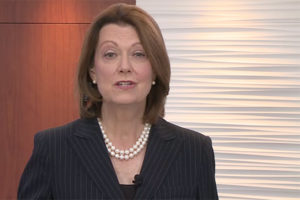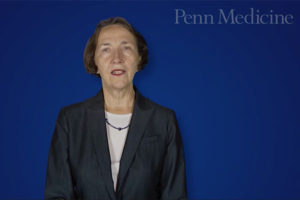
Joanne M. Conroy, MD
Now is time for anesthesiologists to lead the way to gender equity and patient safety. Not despite all of the disruptions that have occurred in 2020, but because of them.
“The pandemic is an example of what broad disruption looks like. It has changed our lives,” said Joanne M. Conroy, MD, President and CEO of Dartmouth-Hitchcock and Dartmouth-Hitchcock Health, during yesterday’s Rovenstine Lecture. “During times of crisis, no one needs convincing that change is necessary.”
Her lecture, “Vital Signs: Transforming 21st Century Anesthesia Practice,” highlighted how the 21st century is a transformative time in anesthesia practice. This year’s disruption will require anesthesiologists to closely examine how they work across health systems, how they embrace technology, and how they determine value and payment, she said. It will also spotlight the disparity in the workforce, where 1/3 of women anesthesiologists are still underpaid and more vulnerable to economic downturns.
“Because of the pandemic, our economy is changing. Industries with face-to-face orientation … have been devasted by COVID, but tech sectors have dominated and now account for almost 20% of the S&P (500 Index),” Dr. Conroy said. “We must consider the long-term economic impact.”
COVID-19 brought telehealth roaring into the mainstream, and with it, more accessibility to specialties that weren’t available before via a virtual platform. Rural affiliates can now seamlessly access this type of care.
“Telehealth is here to stay, as long as it remains cost-effective,” she said.
“Digital health replaces the face-to-face with virtual interactions. If you don’t want to wait to see a doctor – or if you are among the 30% of millennials who don’t even have a doctor – you just download an app,” Dr. Conroy said. “As many as 50-70% of visits could be replaced by online assessments. Most American’s weren’t interested in that before, but that has changed, especially in rural areas.”
Disruption has also changed the way we work.
“Remote work is here to stay,” she said. “It happened overnight and has altered the way we work forever and for the better.” Not only has working remotely upped productivity and job satisfaction, it also could broaden the pool from which professionals are chosen, offering a national platform for recruitment. “Many back-office functions we manage can and will be remote in the future,” she said.
Changing the way we do business also means making it more equitable for women, said Dr. Conroy, who is co-founder of Women of Impact, a nonpartisan group of 60 female health care leaders representing all sectors of the health care industry across the nation, who believe that health care for all will be improved with more women in leadership.
From 2011-2016, the financial performance of U.S. companies with at least three women on the board had median gains in return on equity 11% higher and 45% higher per share earnings than companies with no women directors.
“So why is it taking so long to achieve equity in leadership? Something doesn’t make sense,” Dr. Conroy said, adding that at the rate things are going, there won’t be parity in leadership until nearly 2050.
Women also make less money than men across every profession, she said, pointing to the unconscious bias that interferes with advancement and the “motherhood penalty.” When female caregiving is visible at work (if pictures of their children are displayed), it triggers doubts and uncertainty about their ability.
A post-pandemic world will have winners and losers when it comes to women in business, but “Anesthesiologists should set an example, step up, and fix this within our specialty now,” she said.
The leadership of anesthesiologists continued to be highlighted as Dr. Conroy explained the critical need for new and bold safety strategies.
“We have been talking about safety in Rovenstine Lectures for years. When are we going to start swimming upstream and take leadership positions outside of our specialty?” she asked.
Dr. Conroy said that using existing data to predict and prevent deaths will save lives, reduce cost of care, and also reduce litigation waste and inefficiencies.
“We are in a preferred position as a specialty to step up to this challenge,” she said. “We have a good track record of safety. It’s time to step out of our specialty and step up to lead this country. We must just do it.”

Patricia A. Kapur, MD
Just before introducing Dr. Conroy as this year’s Rovenstine Lecturer, ASA President Mary Dale Peterson, MD, FASA, introduced this year’s award recipients.
Patricia A. Kapur, MD, was presented the 2019 Distinguished Service Award. In a brief acceptance speech, the former Rovenstine Lecturer offered her reflection on the current COVID pandemic and how it impacts anesthesiology, saying that it won’t be possible to totally roll back the more widespread use of telemedicine, and anesthesiologists should adapt to it. She also called for anesthesiologists to turn their attention to systems of delivery service to look for ways to meaningfully be part of lowering the cost of care.
“I have seen so many exciting things happen and seen our profession rise to extraordinary heights,” Dr. Kapur said. “I know we will continue to lead to meet the known and unknown challenges of the future.”
Other award recipients were also recognized before the lecture, including:
- Ru-Rong Ji, PhD, ASA Award for Excellence in Research
- Robert D. Sanders, BSc, MBBS, PhD, FRCA, James E. Cottrell, MD, Presidential Scholar Award
- Albert J. Varon, MD, MHPE, FCCM, ASA Excellence in Education Award
- Elizabeth T. Drum, MD, FAAP, FCPP, FASA, Nicholas M. Greene Award
Twelve recipients were also recognized with the ASA-SEA Distinguished Educator in Anesthesiology Award:
- Wendy Bernstein, MD, MBA, FASA
- Nina Deutsch, MD
- Robert Isaak, DO, FASA
- Lynn Knox, MD, FASA
- Vigi Kurup, MD
- Yan Lai, MD, FASA
- Bryan Mahoney, MD, FASA
- Meg Rosenblatt, MD, FASA
- Laurence Torsher, MD
- Richard Urman, MD, MBA, FASA
- Manuel Vallejo Jr., MD, DMD, FASA
- George Williams II, MD, FCCM, FCCP, FASA
